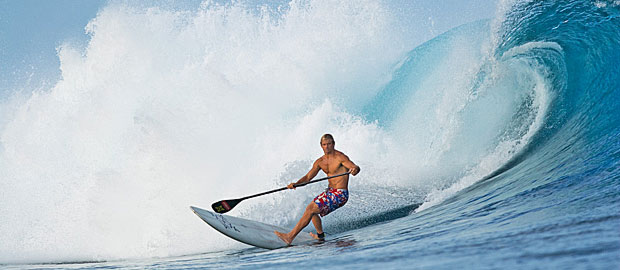sierraclub.org - sierra magazine - may/june 2009 - heightened observations


Heightened Observations
The paddling perspective improves when you get up off your belly

No one has done more to popularize the sport of stand-up paddle surfing than Laird Hamilton, pictured here in Indonesia.
The surf looks different when you paddle out standing up. It all looks different, especially things that sway and dart and eat each other underwater--leathery bull kelp, Crayola starfish, bubbly sea grapes, the occasional seal torpedo. Sometimes I wonder if my change in perspective would apply as well to sharks.
For 40 years I'd been paddling a surfboard the traditional way: on my belly, eyes at sea level, attention tuned to the telltale shadow play of incoming swell. Then last summer, risking ridicule from my too-cool brethren, I bought a stand-up paddleboard (SUP), a craft streamlined for wave riding but as stable as a fishing dock when motionless. At ten feet long, two feet wide, and five inches thick, it has about four times the mass of my everyday board. The idea is to stay on your feet from launch to landing, propelling through the water with a paddle apparently purloined from a gondola.
I took up SUPing because several people (including Laird Hamilton, surfing's Charles Atlas) raved about the workout it provides. I should note that I hate working out. I've avoided inheriting my father's apple-on-a-stick physique only because my pastime of choice--surfing--happens to require upper-body effort. So SUPing seemed ideal: Stay healthy, get strong, have fun.
The first few sessions left me frustrated and sore. Imagine balancing for an hour on an exercise ball while doing ab-enhancing arm pulls; the post-session trudge from shore to car had never felt so long. But once the tumblers aligned, I surged with that adolescent wave lust that keeps surfers at sea long after their arms beg for rest. My stomach muscles strengthened. My posture straightened. I slept better.
Because it glides like a canoe, the stand-up board has taken me places where traditional surfers rarely ride. My favorite is a cove I'd watched for years from my living room window, never imagining its soft waves were worth the extended kelp-obstructed paddle or the area's history of "encounters" with white sharks.
During the long, slow paddle to and from the break, I began studying heretofore unnoticed sea life below. It shamed me to realize I couldn't identify things I'd been seeing for decades. Contrite, I endeavored to learn both genus and species: bat stars and kelp crabs and all manner of saltwater algae--sea palms, bladder wrack, feather boa, and dead man's fingers, which looks all squishy and cute until you find out its name.
Although I try not to let myself think about the sharks--reasoning, probably naively, that balancing upright on a five-inch-thick plank lessens one's chances of getting fatally chomped--it's impossible to wash away thoughts of apex predators in a cove so teeming with life. But I find some small comfort in this: If Carcharodon carcharias ever bursts up from the bottom to sup on my SUP, at least now I'll know its true name.
ON THE WEB See video of stand-up paddle surfers in action.
Steve Hawk lives in Half Moon Bay, California.
Photo: Servais/A-Frame